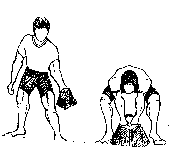Lesson 2: EMG Biopac Student Lab V3.0
I. INTRODUCTION
Mechanical work, in the physical sense,
refers to the application of a force that
results in the movement of an object.
Skeletal muscle performs mechanical work
when the muscle contracts and an object is
moved, as in lifting a weight. To lift a
weight, your muscles must exert a force
great enough to overcome the weight. If you
exert less force, then the weight does not
move.
|

|
Physiologically, skeletal muscle is stimulated to contract
when the brain or spinal cord activates motor units of the muscle.
Motor units are defined as a motoneuron and all of the
muscle fibers that the motoneuron innervates. An action potential (AP)
in a human
motoneuron always causes an action potential in all of
the muscle fibers of the motor unit. As a matter of fact, humans
generally do not send just
one AP at a time down a motoneuron. Instead, a train
of APs is sent - enough to induce tetany (the sustained fusion of individual
muscle twitches) in the muscle fibers of the motor unit. [A discussion
of motor units and their control was presented in Lesson 1.]
Most human skeletal muscles are composed of hundreds of
motor units (Fig. 2.2). When a skeletal muscle is called on to perform
mechanical work, the number of motor units in the muscle activated by the
brain is proportional to the amount of work to be done by the muscle; the
greater the amount of work to be done, the greater the number of motor
units activated. Thus, more motor units are simultaneously active when
a skeletal muscle lifts 20 kilograms than when the same muscle lifts 5
kilograms.

The brain determines the number of active motor units
required for a muscle to perform a given task by utilizing sensory information
from stretch receptors in the muscle and associated tendons and joint capsules.
For example, when lifting a bucket of water from the ground, the brain
first activates several motor units in the requisite skeletal muscles.
If sensory information returning from the muscles indicates the muscles
are contracting but not developing adequate power to lift the bucket, the
brain activates additional motor units until the sensory information indicates
the bucket is being lifted. The sequential activation of motor units to
perform a designated task is called motor unit recruitment.
Once you have lifted a light object, the brain recruits
approximately the same number of motor units to keep the object up, but
cycles between different motor units. The muscle fibers consume stored
energy available in the muscle, and generate a force by contracting. As
the muscle fibers deplete this fuel source, more energy must be created
in order to continue contracting. By recruiting different motor units,
motor units can relax and replenish their fuel sources.
Skeletal muscles performing acute maximum work or chronic
submaximum work of a repetitive nature will eventually fatigue. Fatigue
is defined as a decrease in the muscle's ability to generate force. Fatigue
is caused by a reversible depletion of the muscle's fuel supply. If the
muscle uses its energy sources faster than it can be generated by cellular
metabolism, fatigue occurs. During contraction, skeletal muscle cells convert
chemical energy into thermal and mechanical energy, and, in the process,
produce chemical waste products.
Normally the waste products are removed from the muscle
by the circulatory system as the blood brings nutrients to the muscle for
energy transformation. If certain waste products (metabolites) are not
removed at an adequate rate, they will accumulate and chemically interfere
with the contractile process, thereby hastening the onset of fatigue. Some
accumulated waste products also stimulate pain receptors in surrounding
connective tissue and induce cramping of skeletal muscle, a general sign
of inadequate blood flow to the muscle.
In this lesson, you will examine motor unit recruitment
and skeletal muscle fatigue by combining electromyography with dynamometry.
When a motor unit is activated, the component muscle fibers
generate and conduct their own electrical impulses, which cause the fibers
to
contract. Although the electrical impulse generated and
conducted by each fiber is very weak (less than 100 microvolts), many fibers
conducting simultaneously induce voltage differences in the overlying
skin which are large enough to be detected by a pair of surface electrodes.
The detection, amplification, and recording of changes
in skin voltage produced by underlying skeletal muscle contraction is called
electromyography, and the recording thus obtained is called an electromyogram
(EMG).
Power is defined as the amount of work done per unit of
time. Dynamometry means the measurement of power (dyno = power, meter =
measure), and the graphic record derived from the use of a dynamometer
is called a dynagram.
In this lesson, the power of contraction of clench muscles
will be determined by a hand dynamometer equipped with an electronic transducer
for recording.
The BIOPAC system will simultaneously record three bands
of information:
1) The force you exert on the transducer,
2) The electrical signal produced by the muscle during
contraction, and
3) The integrated waveform, which is an indication of
the activity levels of the muscle.
II. EXPERIMENTAL OBJECTIVES
1) To determine the maximum clench strength for right
and left hands and compare differences between male and female.
2) To observe, record, and correlate motor unit recruitment
with increased power of skeletal muscle contraction.
3) To record the force produced by clench muscles, EMG,
and integrated

